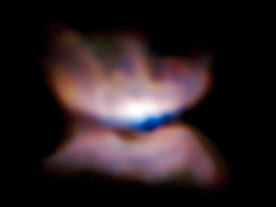Monster Galaxy Found Near Edge of Universe
A group of researchers imaged a “monstrous galaxy” – SDP.81, located some 11.7 billion light-years from Earth, using the Atacama Large Millimeter/sub-millimeter Array (ALMA) in Chile and a natural magnification method called “gravitational lensing.”
The researchers used the gravity of a massive galaxy 3.4 billion light-years away to magnify the image of the galaxy located in the far reaches of the known universe.
Most of the World’s Population Has at Least One Health Problem
A new in-depth analysis from the Global Burden of Diseases, Injuries, and Risk Factors Study (GBD) shows that 95 percent of the world’s population – more than 7 billion people – had health problems in 2013.
One third of the global population experienced more than five ailments during that year.
The researchers, writing in the medical journal The Lancet, warned that with a growing world population and an increased proportion of elderly people, the percentage of people living with less than perfect health is set to rise dramatically in the coming decades.
Building the Perfect Bonfire
The most efficient way to construct a fire is the one people have used for thousands of years, according to new research conducted by Adrian Bejan, a professor of mechanical engineering at Duke University.
Writing in the journal, Nature Scientific Reports, Bejan advised that wood and kindling should be stacked in pyramid fashion and that the pyramid should be as high as it is wide.
Curiosity, Other Mars Mission Take Time Out
NASA’s Jet Propulsion Laboratory has given the Curiosity rover and its other Mars missions a vacation.
Right now, the sun is somewhere between Mars and Earth – a phenomenon known as the Mars solar conjunction that disrupts communication between the two planets.
So to prevent any possible harm to its Mars orbiters and rovers as a result of any possible miscommunication between the Red Planet and Earth, NASA temporarily stopped sending any operational commands to Mars from Sunday June 7 to June 21.
Study Shows May Births Have Lower Disease Risk
Scientists from Columbia University recently discovered links between disease risk and a person’s birth month.
The researchers created a computer algorithm that analyzed various medical databases in New York City and linked 55 diseases with the season of a person’s birth.
Writing in the Journal of American Medical Informatics Association, the research team said their study showed that people who were born in May had the lowest risk of disease, while those born five months later in October had the highest disease risk.























Comments are closed.